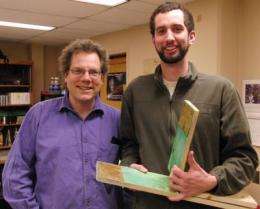Physicists devise new way to analyze a bloody crime scene

Don't get him wrong: Fred Gittes is, in his words, "extremely squeamish."
But then a scientist with forensics training told him that crime scene investigators could use a better way to analyze blood spatters. The physicist in Gittes rose to the challenge.
"It seems as though what was being done was very crude from a physics point of view and that intrigued me," he says.
Along with Chris Varney, a doctoral candidate in physics, Gittes has worked out a system that can often determine exactly where blood spatters originate, a critical piece of evidence in not only solving a crime but securing a conviction. A paper on their research, demurely titled "Locating the Source of Projectile Fluid Droplets," has now been accepted for publication in the American Journal of Physics and posted online.
Until now, investigators have been able to determine the direction a drop of blood has come from, with a stain's elliptical shape practically pointing to it. They've even been able to nail down a source along a vertical line. But the tougher part is figuring out how high up the source was.
"I talked informally with a public defender and he said that it's crucial to know the height because so often it's a self-defense issue," Gittes says. "A defendant may claim that a victim was standing rather than sitting. That's a big deal, apparently."
Gittes and Varney started tackling the problem with a clapper—two boards on a hinge that could be clapped over a liquid, producing a spatter from a known and measurable height and angle. To get a liquid with blood-like impact shapes, they tinkered with corn syrup, food coloring and a variety of sauces before settling on a blend of Ashanti chicken wing sauce and Ivory dish soap.
Most of the math they used is at about the level of first-semester college physics. We'll spare you most of it, except to say they worked back from measurements of known spatters and sources and found that well known equations of projectile motion could be used to develop a formula giving them the height of a liquid's origin.
They also realized that, plotted on a graph with x and y axes, data points on specific drops form a neat line when the formula is working correctly. If drops are launched from too wide a range of angles, the method won't work and the data points won't line up, preventing investigators from making a false conclusion.
Gittes says he is chiefly interested in the new approach as a teaching tool, and a WSU geologist has expressed an interest in using similar methods to study lava fountains and volcanic debris. Gittes says he is content to leave any forensic application to crime scene investigators. Besides, he is way too squeamish.
More information: Locating the source of projectile fluid droplets, Christopher R. Varney, Fred Gittes, Available at arXiv:1102.5134v2 [physics.pop-ph]
Abstract
The ill-posed projectile problem of finding the source height from spattered droplets of viscous fluid is a longstanding obstacle to accident reconstruction and crime scene analysis. It is widely known how to infer the impact angle of droplets on a surface from the elongation of their impact profiles. However, the lack of velocity information makes finding the height of the origin from the impact position and angle of individual drops not possible. From aggregate statistics of the spatter and basic equations of projectile motion, we introduce a reciprocal correlation plot that is effective when the polar launch angle is concentrated in a narrow range. The vertical coordinate depends on the orientation of the spattered surface, and equals the tangent of the impact angle for a level surface. When the horizontal plot coordinate is twice the reciprocal of the impact distance, we can infer the source height as the slope of the data points in the reciprocal correlation plot. If the distribution of launch angles is not narrow, failure of the method is evident in the lack of linear correlation. We perform a number of experimental trials, as well as numerical calculations and show that the height estimate is insensitive to aerodynamic drag. Besides its possible relevance for crime investigation, reciprocal-plot analysis of spatter may find application to volcanism and other topics and is most immediately applicable for undergraduate science and engineering students in the context of crime-scene analysis.
Provided by Washington State University



















